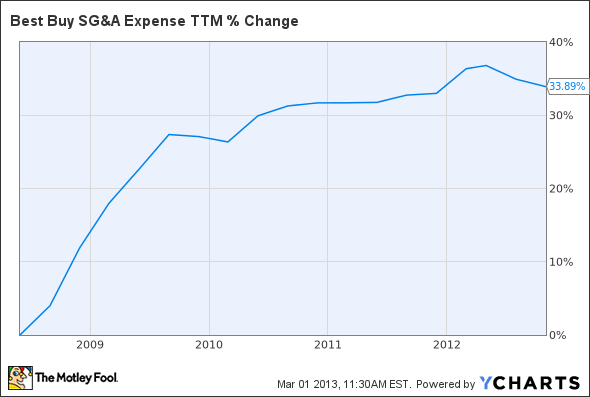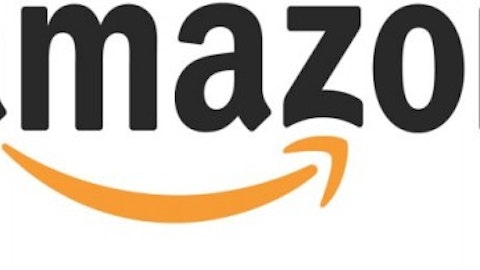Over the past five years, electronics retailer Best Buy Co., Inc. (NYSE:BBY) has unwillingly become the poster boy of dying big box retailers. Increased competition from e-commerce companies, such as Amazon.com, Inc. (NASDAQ:AMZN) and eBay, has dampened the company’s chances of recovery. Yet the company recently posted fourth quarter earnings that represented strong growth from the prior year quarter, topping analyst expectations on both the top and bottom lines. Is it time to take a second look at the company, to see if Best Buy is a better buy today than it was yesterday?
For its fourth quarter, Best Buy posted a loss of $1.21 per share, or $409 million – a vast improvement over the loss of $5.17 per share, or $1.82 billion, it posted in the prior year quarter. Excluding one-time charges and adjustments, Best Buy earned $1.64 per share, topping the analyst estimate of $1.53 on the same basis.
It also reported revenue of $16.71 billion, up from $16.67 billion a year earlier, beating the consensus forecast of $16.32 billion.
Same-Store Sales
Best Buy’s same-store sales in the United States rose 0.9%, finally stabilizing and ending two years of painful declines. Online revenue rose 11%.
However, international same-store sales, which includes stores in Europe, Canada and China, plunged 6.6%. Best Buy surprisingly posted positive growth in crisis-stricken Europe, but those gains were offset by declines in Canada and China. Best Buy attributed its weakness in Canada to softness in its retail electronics industry, while Chinese stores suffered from increased competition and expired government stimulus programs.
Big Showrooms
Best Buy and its big box retailer peers have suffered immensely at the hands of Amazon and eBay. Customers now tend to use big box stores such as Best Buy and Target as “showrooms” for purchases from online sources, which usually offer better deals. Smartphone apps, such as Barcode Scanners, have exacerbated the problem as shoppers are able to instantly check if they can get a better deal online.
This has forced Best Buy to match Amazon’s prices dollar for dollar. In retaliation, Amazon now offers “Super Saver Shipping” for purchases over $25, which takes shipping costs out of the equation. Analysts had been worried that this aggressive strategy would crimp margins, but it only reduced gross margins slightly from the prior year – from 23.1% down to 22.6%.
Renew Blue
CEO Hubert Joly’s plan, dubbed “Renew Blue,” is focused on spurring growth into fiscal 2014, by focusing on six key areas:
- Accelerating online growth
- Escalating the multi-channel customer experience
- Increasing revenue and gross profit per square foot by optimizing large stores
- Reducing costs by eliminating supply chain deficiencies
- Optimizing the U.S. real estate portfolio
- Reducing Sales, General & Administrative Costs
Sales, General & Administrative Costs have been a sore spot for the company, as seen in the chart below.

BBY SG&A Expense TTM data by YCharts
However, if Joly is truly focused on selling off or renting non-performing real estate properties, he is likely to also reduce the size of Best Buy’s massive stores to boost profit per square foot.
These smaller properties, along with possible reductions in the workforce, could reduce SG&A costs considerably. Joly has already laid off 400 workers at Best Buy’s headquarters in Richfield, Minn. He also closed 15 non-performing stores in Canada.
Joly urged patience, stating, “We recognize, however, that fiscal 2014 is a year of transition and that further investment will be required to advance our Renew Blue transformation.”
Versus Competitors
How have Best Buy’s primary brick-and-mortar electronic retailer peers, Conn’s (NASDAQ:CONN) and RadioShack (NYSE:RSH), fared in the face of Amazon’s aggression?
| Forward P/E | 5-year PEG | Price to Sales (ttm) | Price to Book | Debt to Equity | Return on Equity (ttm) | Profit Margin | |
| Best Buy | 7.53 | -0.99 | 0.11 | 1.58 | 48.74 | 5.66% | -2.43% |
| Conn’s | 15.33 | 1.29 | 1.25 | 2.64 | 83.45 | 11.52% | 5.07% |
| Radio Shack | N/A | 0.05 | 0.07 | 0.50 | 129.90 | -20.62% | -3.27% |
| Best Value | Best Buy | RadioShack | RadioShack | RadioShack | Best Buy | Conn’s | Conn’s |
Source: Yahoo Finance, March 1.
While Radio Shack is obviously the stock of choice for bottom-fishing value investors, the stock’s 58% plunge over the past twelve months and its negative profit margins make it an unacceptably risky choice. Conn’s, on the other hand, has the strongest margins as well as the most robust performance over the past year, and as a result it is trading at a premium to its peers. Best Buy’s strengths are its comparatively lower debt levels and reasonably cheap forward valuation.
Best Buy also exhibits much stronger top line growth versus its competitors.
BBY Revenue TTM data by YCharts
Unfortunately, Best Buy’s profits aren’t synchronized to its revenue growth. The company’s diluted EPS plunged 230.7% over the past five years, woefully underperforming its rivals.
BBY EPS Diluted TTM data by YCharts
Lastly, all three brick-and-mortar electronics retailers suffer from a similar problem – declining free cash flow and cash reserves.
BBY Free Cash Flow TTM data by YCharts
However, Best Buy finished the fourth quarter with adjusted free cash flow of $965 million, in line with its own guidance of $850 million to $1.05 billion – which means investors shouldn’t be worried about the company’s cash flow drying up anytime soon.
Takeover aborted, for now
Best Buy’s founder Richard Schulze made headlines last year after he announced that he was interested in buying the company and taking it private. Schulze, who owns approximately 20% of the company, was originally a chairman of the board.
Schulze spent most of last summer attempting to secure financing and support from private equity firms to take Best Buy private. He previously submitted a proposed buyout that valued Best Buy at $8 billion, a significant premium to its current $5.63 billion market cap – which excited investors considerably and sent shares on a wild, news-fueled roller coaster ride.
Although Best Buy delayed its fourth quarter earnings release to give Schulze more time to work out a bid, a deal appears to be off the table for now. However, many investors believe Schulze could return to the table soon, especially after the market’s warm response to its better-than-expected earnings. That wild card could cause shares to unexpectedly rally.
The Foolish Bottom Line
Best Buy’s results are not indicative of a full turnaround. Rather, these are the first flickers of life from a company beaten down by years of declines. For the first time in a long while, Best Buy’s same-store sales are positive, its earnings per share are inching back towards profitability, and the company has a clear plan for recovery by the end of fiscal 2014. That’s more than investors could have hoped for a year ago – and that makes it a better buy today than it was yesterday.
The article Is Best Buy Finally a Better Buy? originally appeared on Fool.com.
Copyright © 1995 – 2013 The Motley Fool, LLC. All rights reserved. The Motley Fool has a disclosure policy.









